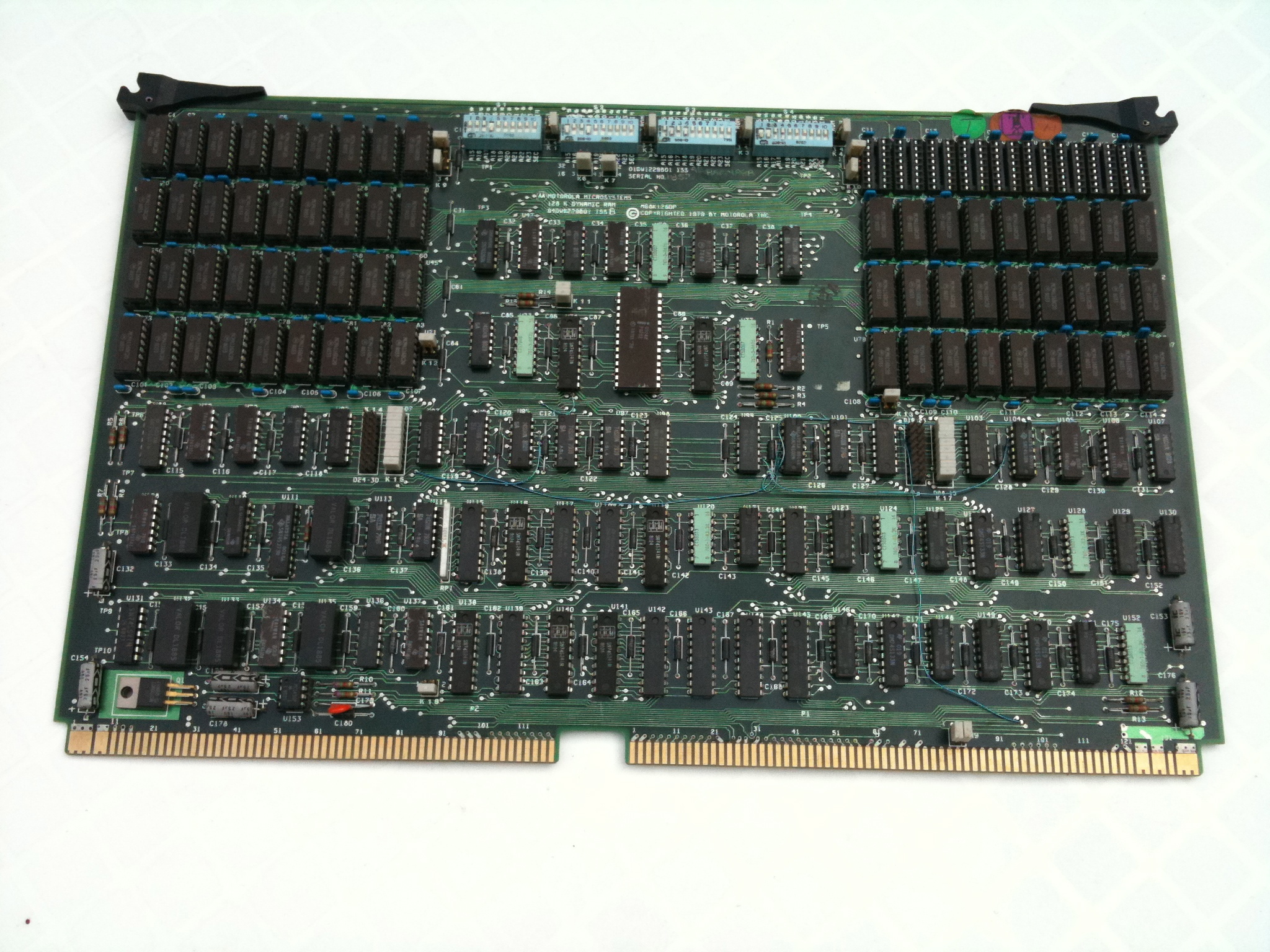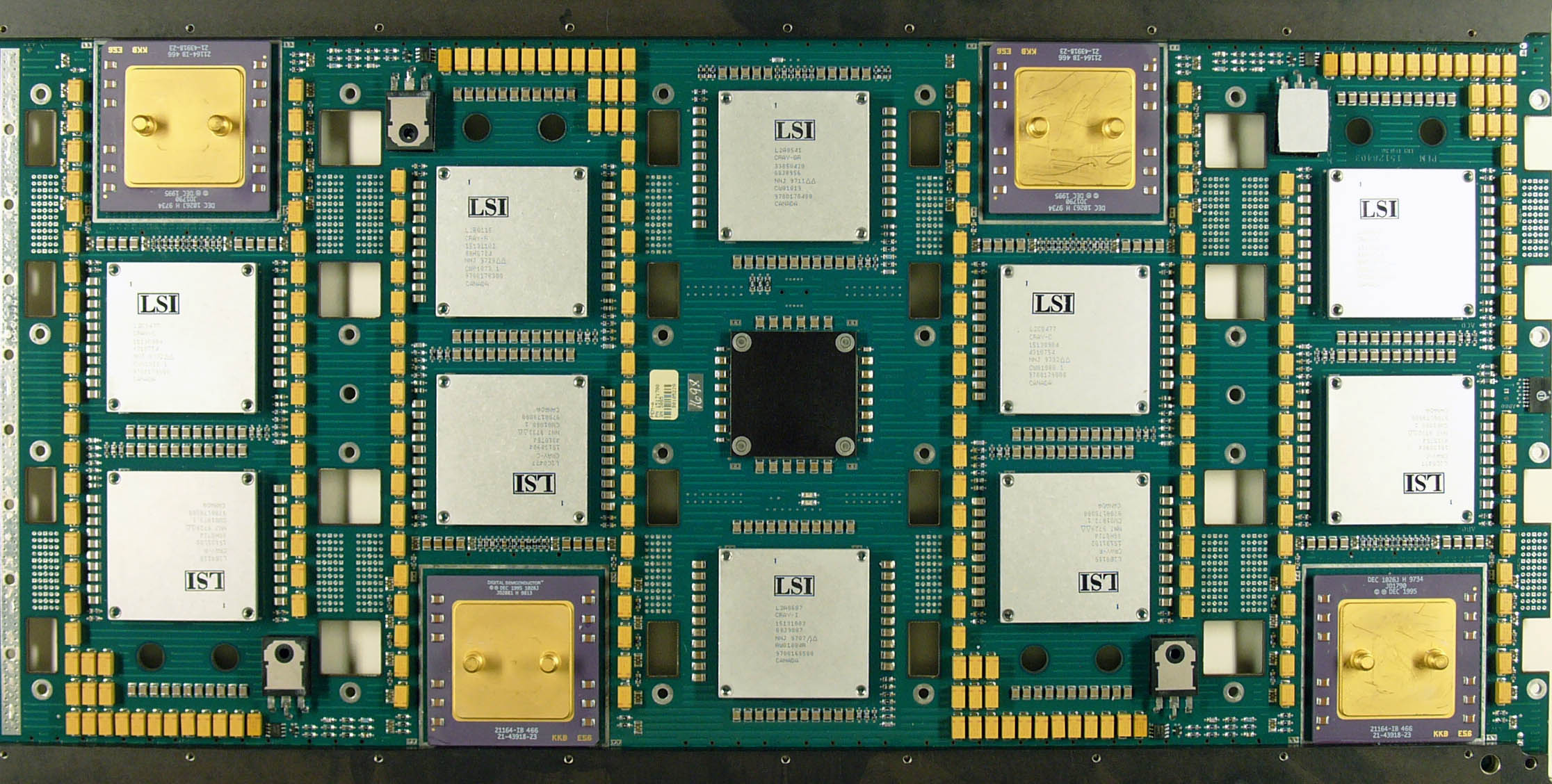|
Cray APP
The Cray APP (''Attached Parallel Processor'') was a parallel computer sold by Cray Research from 1992 onwards. It was based on the Intel i860 microprocessor and could be configured with up to 84 processors. The design was based on "computational nodes" of 12 processors interconnected by a shared bus, with multiple nodes connected to each other, memory and I/O nodes via an 8×8 crossbar switch. The APP was marketed as a "matrix co-processor" system and required a SPARC-based host system to operate, such as the Cray S-MP. Connection to the host system was via VMEbus or HiPPI. A fully configured APP had a peak performance of 6.7 (single-precision) gigaflops. The APP was originally designed by FPS Computing Floating Point Systems, Inc. (FPS), was a Beaverton, Oregon vendor of attached array processors and minisupercomputers. The company was founded in 1970 by former Tektronix engineer Norm Winningstad, with partners Tom Prince, Frank Bouton and Robe ... as the FPS MCP-784. FPS were ... [...More Info...] [...Related Items...] OR: [Wikipedia] [Google] [Baidu] |
Parallel Computer
Parallel computing is a type of computation in which many calculations or processes are carried out simultaneously. Large problems can often be divided into smaller ones, which can then be solved at the same time. There are several different forms of parallel computing: bit-level, instruction-level, data, and task parallelism. Parallelism has long been employed in high-performance computing, but has gained broader interest due to the physical constraints preventing frequency scaling.S.V. Adve ''et al.'' (November 2008)"Parallel Computing Research at Illinois: The UPCRC Agenda" (PDF). Parallel@Illinois, University of Illinois at Urbana-Champaign. "The main techniques for these performance benefits—increased clock frequency and smarter but increasingly complex architectures—are now hitting the so-called power wall. The computer industry has accepted that future performance increases must largely come from increasing the number of processors (or cores) on a die, rather than ma ... [...More Info...] [...Related Items...] OR: [Wikipedia] [Google] [Baidu] |
Cray Research
Cray Inc., a subsidiary of Hewlett Packard Enterprise, is an American supercomputer manufacturer headquartered in Seattle, Washington. It also manufactures systems for data storage and analytics. Several Cray supercomputer systems are listed in the TOP500, which ranks the most powerful supercomputers in the world. Cray manufactures its products in part in Chippewa Falls, Wisconsin, where its founder, Seymour Cray, was born and raised. The company also has offices in Bloomington, Minnesota (which have been converted to Hewlett Packard Enterprise offices), and numerous other sales, service, engineering, and R&D locations around the world. The company's predecessor, Cray Research, Inc. (CRI), was founded in 1972 by computer designer Seymour Cray. Seymour Cray later formed Cray Computer Corporation (CCC) in 1989, which went bankrupt in 1995. Cray Research was acquired by Silicon Graphics (SGI) in 1996. Cray Inc. was formed in 2000 when Tera Computer Company purchased the Cray Res ... [...More Info...] [...Related Items...] OR: [Wikipedia] [Google] [Baidu] |
Intel I860
The Intel i860 (also known as 80860) is a RISC microprocessor design introduced by Intel in 1989. It is one of Intel's first attempts at an entirely new, high-end instruction set architecture since the failed Intel iAPX 432 from the beginning of the 1980s. It was the world's first million-transistor chip. It was released with considerable fanfare, slightly obscuring the earlier Intel i960, which was successful in some niches of embedded systems, and which many considered to be a better design. The i860 never achieved commercial success and the project was terminated in the mid-1990s. Implementations The first implementation of the i860 architecture is the i860 XR microprocessor (code-named N10), which ran at 25, 33, or 40 MHz. The second-generation i860 XP microprocessor (code named N11) added 4 Mbyte pages, larger on-chip caches, second level cache support, faster buses, and hardware support for bus snooping, for cache consistency in multiprocessor systems. A process ... [...More Info...] [...Related Items...] OR: [Wikipedia] [Google] [Baidu] |
Microprocessor
A microprocessor is a computer processor where the data processing logic and control is included on a single integrated circuit, or a small number of integrated circuits. The microprocessor contains the arithmetic, logic, and control circuitry required to perform the functions of a computer's central processing unit. The integrated circuit is capable of interpreting and executing program instructions and performing arithmetic operations. The microprocessor is a multipurpose, clock-driven, register-based, digital integrated circuit that accepts binary data as input, processes it according to instructions stored in its memory, and provides results (also in binary form) as output. Microprocessors contain both combinational logic and sequential digital logic, and operate on numbers and symbols represented in the binary number system. The integration of a whole CPU onto a single or a few integrated circuits using Very-Large-Scale Integration (VLSI) greatly reduced the cost of ... [...More Info...] [...Related Items...] OR: [Wikipedia] [Google] [Baidu] |
Crossbar Switch
In electronics and telecommunications, a crossbar switch (cross-point switch, matrix switch) is a collection of switches arranged in a matrix configuration. A crossbar switch has multiple input and output lines that form a crossed pattern of interconnecting lines between which a connection may be established by closing a switch located at each intersection, the elements of the matrix. Originally, a crossbar switch consisted literally of crossing metal bars that provided the input and output paths. Later implementations achieved the same switching topology in solid-state electronics. The crossbar switch is one of the principal telephone exchange architectures, together with a rotary switch, memory switch, and a crossover switch. General properties A crossbar switch is an assembly of individual switches between a set of inputs and a set of outputs. The switches are arranged in a matrix. If the crossbar switch has M inputs and N outputs, then a crossbar has a matrix with ''M'' × ... [...More Info...] [...Related Items...] OR: [Wikipedia] [Google] [Baidu] |
SPARC
SPARC (Scalable Processor Architecture) is a reduced instruction set computer (RISC) instruction set architecture originally developed by Sun Microsystems. Its design was strongly influenced by the experimental Berkeley RISC system developed in the early 1980s. First developed in 1986 and released in 1987, SPARC was one of the most successful early commercial RISC systems, and its success led to the introduction of similar RISC designs from many vendors through the 1980s and 1990s. The first implementation of the original 32-bit architecture (SPARC V7) was used in Sun's Sun-4 computer workstation and server systems, replacing their earlier Sun-3 systems based on the Motorola 68000 series of processors. SPARC V8 added a number of improvements that were part of the SuperSPARC series of processors released in 1992. SPARC V9, released in 1993, introduced a 64-bit architecture and was first released in Sun's UltraSPARC processors in 1995. Later, SPARC processors were used in symm ... [...More Info...] [...Related Items...] OR: [Wikipedia] [Google] [Baidu] |
Cray S-MP
The Cray S-MP was a multiprocessor server computer sold by Cray Research from 1992 to 1993. It was based on the Sun SPARC microprocessor architecture and could be configured with up to eight 66 MHz BIT B5000 processors. Optionally, a Cray APP matrix co-processor cluster could be added to an S-MP system. The S-MP was originally designed by FPS Computing as the FPS Model 500EA. FPS were acquired by Cray Research in 1991, becoming Cray Research Superservers Inc., and the Model 500EA was relaunched by Cray in 1992 as the S-MP. The S-MP was a short-lived model, and was superseded by the Cray CS6400 The Cray Superserver 6400, or CS6400, is a discontinued multiprocessor server computer system produced by Cray Research Superservers, Inc., a subsidiary of Cray Research, and launched in 1993. The CS6400 was also sold as the Amdahl SPARCsummit 6400 .... References ''New Computer by Cray Research Uses Sun Processor'', New York TimesCockcroft, Adrian and Pettit, Richard (1998), ''Sun Perform ... [...More Info...] [...Related Items...] OR: [Wikipedia] [Google] [Baidu] |
VMEbus
VMEbus (Versa Module Europa or Versa Module Eurocard bus) is a computer bus standard, originally developed for the Motorola 68000 line of CPUs, but later widely used for many applications and standardized by the IEC as ANSI/IEEE 1014-1987. It is physically based on Eurocard sizes, mechanicals and connectors (DIN 41612), but uses its own signalling system, which Eurocard does not define. It was first developed in 1981 and continues to see widespread use today. History In 1979, during development of the Motorola 68000 CPU, one of their engineers, Jack Kister, decided to set about creating a standardized bus system for 68000-based systems. The Motorola team brainstormed for days to select the name VERSAbus. VERSAbus cards were large, , and used edge connectors. Only a few products adopted it, including the IBM System 9000 instrument controller and the Automatix robot and machine vision systems. Kister was later joined by John Black, who refined the specifications and creat ... [...More Info...] [...Related Items...] OR: [Wikipedia] [Google] [Baidu] |
Gigaflops
In computing, floating point operations per second (FLOPS, flops or flop/s) is a measure of computer performance, useful in fields of scientific computations that require floating-point calculations. For such cases, it is a more accurate measure than measuring instructions per second. Floating-point arithmetic Floating-point arithmetic is needed for very large or very small real numbers, or computations that require a large dynamic range. Floating-point representation is similar to scientific notation, except everything is carried out in base two, rather than base ten. The encoding scheme stores the sign, the exponent (in base two for Cray and VAX, base two or ten for IEEE floating point formats, and base 16 for IBM Floating Point Architecture) and the significand (number after the radix point). While several similar formats are in use, the most common is ANSI/IEEE Std. 754-1985. This standard defines the format for 32-bit numbers called ''single precision'', as well as 64- ... [...More Info...] [...Related Items...] OR: [Wikipedia] [Google] [Baidu] |
FPS Computing
Floating Point Systems, Inc. (FPS), was a Beaverton, Oregon vendor of attached array processors and minisupercomputers. The company was founded in 1970 by former Tektronix engineer Norm Winningstad, with partners Tom Prince, Frank Bouton and Robert Carter. Carter was a salesman for Data General Corp. who persuaded Bouton and Prince to leave Tektronix to start the new company. Winningstad was the fourth partner. History The original goal of the company was to supply economical, but high-performance, floating point coprocessors for minicomputers. In 1976, the '' AP-120B'' array processor was produced. This was soon followed by a unit for larger systems and IBM mainframes, the FPS AP-190. In 1981, the follow-on ''FPS-164'' was produced, followed by the FPS-264, which had the same architecture. This was five times faster, using ECL instead of TTL chips. These processors were widely used as attached processors for scientific applications in reflection seismology, physical chemi ... [...More Info...] [...Related Items...] OR: [Wikipedia] [Google] [Baidu] |
Cray Products
Cray Inc., a subsidiary of Hewlett Packard Enterprise, is an American supercomputer manufacturer headquartered in Seattle, Washington. It also manufactures systems for data storage and analytics. Several Cray supercomputer systems are listed in the TOP500, which ranks the most powerful supercomputers in the world. Cray manufactures its products in part in Chippewa Falls, Wisconsin, where its founder, Seymour Cray, was born and raised. The company also has offices in Bloomington, Minnesota (which have been converted to Hewlett Packard Enterprise offices), and numerous other sales, service, engineering, and R&D locations around the world. The company's predecessor, Cray Research, Inc. (CRI), was founded in 1972 by computer designer Seymour Cray. Seymour Cray later formed Cray Computer Corporation (CCC) in 1989, which went bankrupt in 1995. Cray Research was acquired by Silicon Graphics (SGI) in 1996. Cray Inc. was formed in 2000 when Tera Computer Company purchased the Cray R ... [...More Info...] [...Related Items...] OR: [Wikipedia] [Google] [Baidu] |



.jpg)


